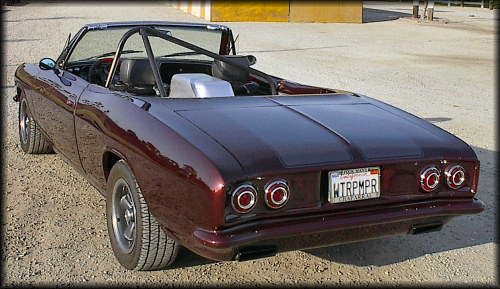

![]()
A stroked 383 cubic-inch Corv-8 Monza Roadster
|
There are many ways to hop-up a Corvair, and clearly Archibald didn't take the easy route. Have a look at the cutaway view below and see the extent to which this car was redesigned and rebuilt. Note that not all the modifications illustrated in the drawing made it on the 383 roadster. The suspension is essentially stock as are the rear brakes. The transmission oil cooler seen over the transaxle in the drawing was relocated to a mounting point behind the grill and ahead of the radiator where engine heat would not interfere with cooling. Maximum transmission oil temperature is held to 125 degrees Fahrenheit; 52 degrees Celsius. |
|
Exterior modifications include painted bumpers, the replacement of stock door handles with flush-mounted pulls, and the removal of wheel arch and rocker trim. Gone are the stock air intakes ahead of the deck lid and exhaust grills below the rear bumper. Rectangular dual exhaust tips from a 3rd generation Z-28 Camaro are artfully integrated into a custom rolled pan, and backup lights give way to a second pair of running, brake and turn signal lights. |
 |
|
At the heart of the matter is a stroked 350 small-block. Engine displacement is increased to 383 cubic-inches though the use of an internally balanced, forged 400 cid Chevy crankshaft. Stroke is increased from 3.48 to 3.75 inches. Feeding those hungry cubes is a Holley carburetor built by Jones in Huntington Beach, California, capable of flowing air and fuel at a rate of 920 cubic feet per minute. An Edelbrock Victor Jr. manifold and matched Edelbrock heads carry the mixture to valves activated by an Isky camshaft, chrome-moly pushrods and extruded aluminum, 1.6:1 ratio roller rockers. The engine makes 450 hp at the rear wheels and has run up to 7400 rpm on a chassis dyno. The only reason this 383 can achieve these numbers is because it's internally balanced, blueprinted, ported and polished and has 6-inch H-beam Eagle connecting rods and forged JE pistons. Earlier, we saw how intake air was routed to the engine through a plenum from the front of the car, passing through the cockpit via the center console. In the picture below, we see the air inlet where it arrives at the air box/air-cleaner assemby. That's ram air from the front in a mid-engine car! |
|
|
|
Under the air-cleaner, a piece of acrylic forms the base of the air box. Plexiglas was chosen so the engine and its mechanics could be easily viewed. Ignition comes from a reworked GM HEI unit firing into 9-mm wires. The exhaust headers were custom made by Doug Holmberg, who made Carroll Shelby's headers for the Cobra cars of the Sixties. The primary tubes are 2-inch id (inside diameter), stepped with a 4-inch collector, all equal length with an X-pipe. They are aluminum coated inside and out. Archibald prefers aluminum as opposed to ceramic coating because the bond improves with each heat cycle. The fuel system is a Bosch return system in which the electric fuel pump over-provides fuel to the carburetor with the excess returned to the fuel tank via a separate line. The pump's head pressure is 120 psi (pounds per square-inch). A regulator near the pump reduces the pressure to 35 psi and a second regulator (shown in the picture) further reduces fuel pressure to 6.5 psi at the carburetor. This configuration was suggested to Archibald by Bonneville record holder, Oz Cheek, and it ensures the carburetor never starves for fuel. At the front of the engine, the only accessory is the alternator. No frills...all business. Bolted to the rear of the engine block, we see the incorporated bell housing of an Art Carr full size Powerglide transmission with 2400 rpm-stall converter. The differential is a beefed up 4-spider, 3.55:1, Corvair Positraction unit. |
Click the road sign for more.
Select from the navigation bar!